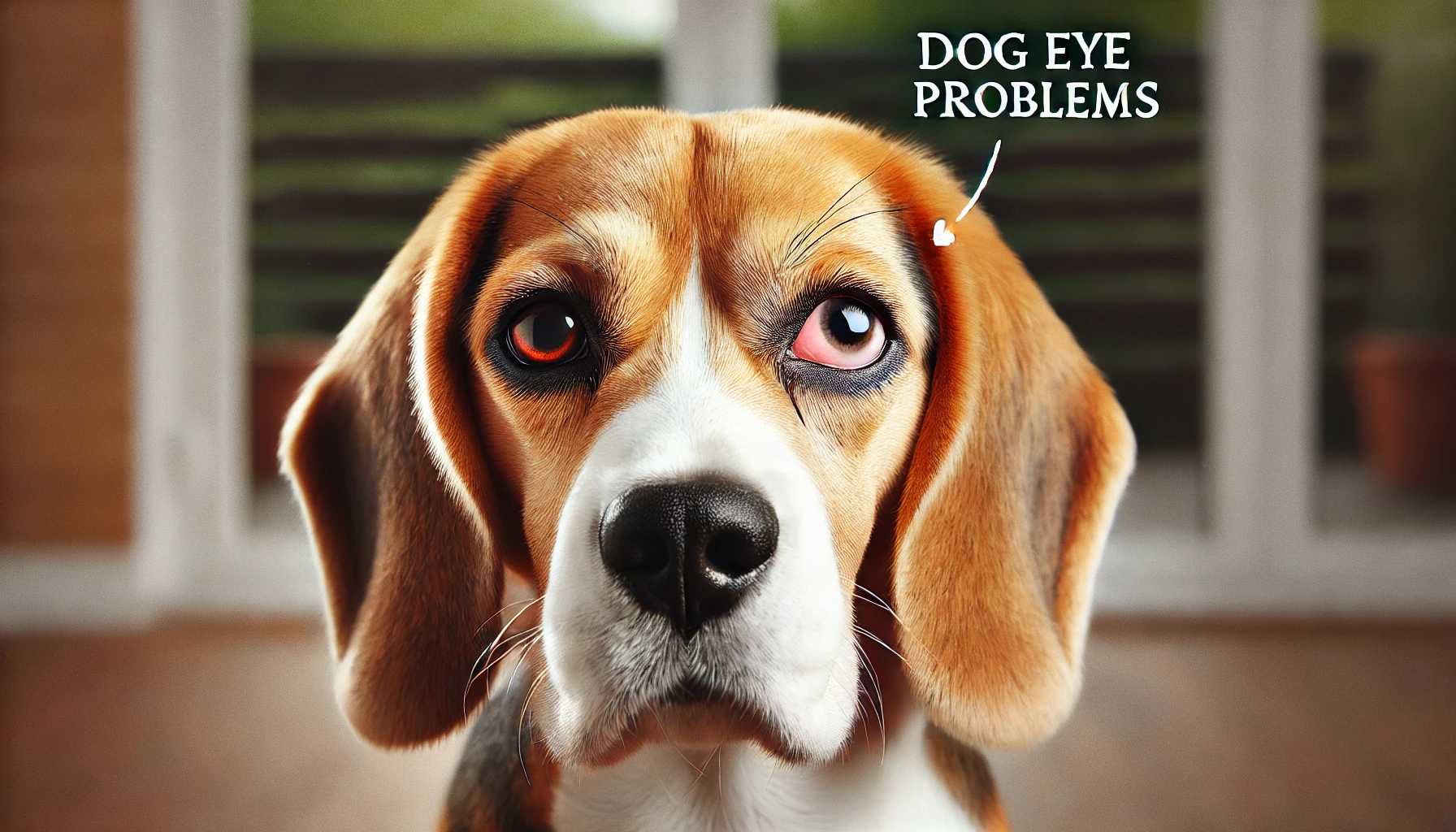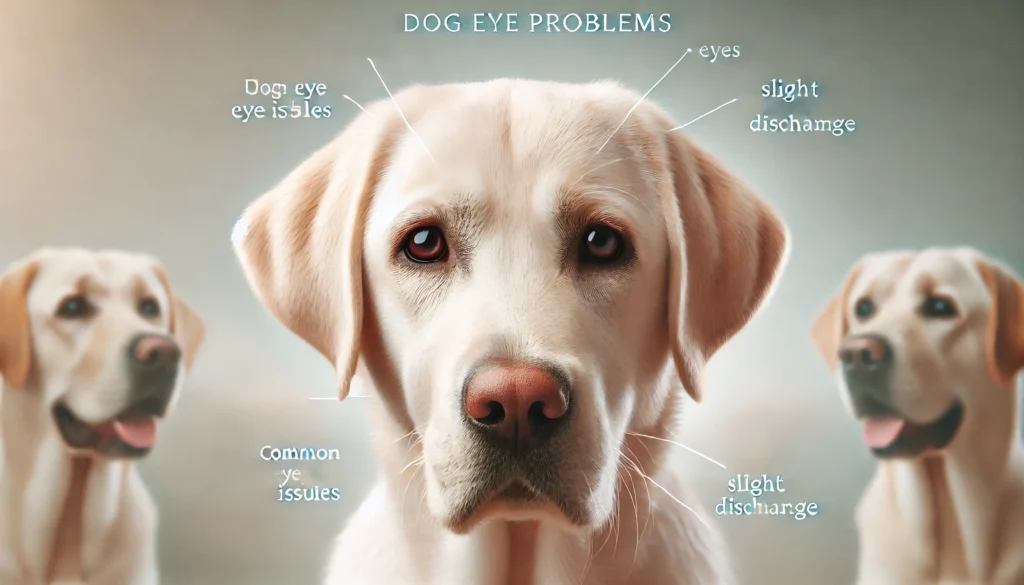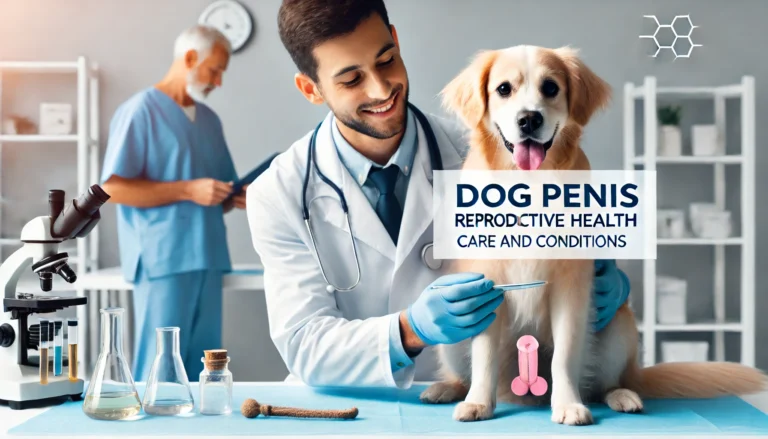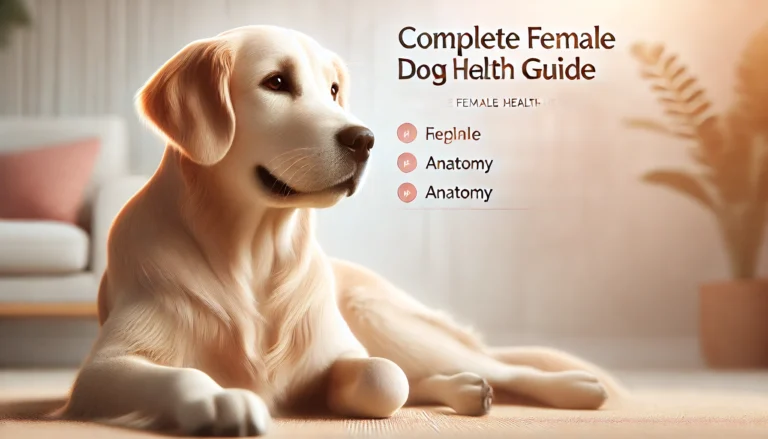Dog Eye Problems: Essential Guide to Treating and Preventing Issues

Dogs rely on their senses to explore the world, and their eyes are no exception. As a pet owner, it’s crucial to be aware of potential dog eye problems, as many of them can go unnoticed until the issue becomes more severe. From common issues like conjunctivitis to more serious conditions like cataracts and glaucoma, dog eye health is a critical component of overall well-being. In this comprehensive guide, we will explore various eye problems in dogs, their causes, symptoms, treatments, and prevention tips to ensure that your furry companion’s eyes stay healthy for years to come.
Common Dog Eye Problems
1. Conjunctivitis (Pink Eye)
Conjunctivitis, commonly known as pink eye, is one of the most frequent dog eye problems. This condition involves inflammation of the conjunctiva, the thin membrane that covers the inner eyelid and the white part of the eye. It can affect one or both eyes and is often caused by allergies, infections, or irritants.
Symptoms of Conjunctivitis:
- Red or pinkish discoloration in the white part of the eye
- Discharge from the eyes, ranging from clear to yellow or green
- Swelling of the eyelids
- Squinting or excessive blinking
Treatment and Prevention:
Dog Eye Problems Treatment for conjunctivitis may involve antibiotic eye drops if it’s caused by a bacterial infection or anti-inflammatory medications for allergic causes. To prevent eye infection in dogs, regular cleaning and keeping irritants away from the dog’s eyes is essential.
2. Cataracts
Cataracts are a clouding of the lens in the eye, and they can lead to partial or total vision loss. Cataracts are more common in senior dogs, but some breeds are genetically predisposed to developing them at an earlier age.
Symptoms of Cataracts:
- Cloudy or bluish-white eyes
- Difficulty seeing, especially in low-light environments
- In some cases, a noticeable glassy eye appearance
Treatment and Prevention:
Dog Eye Problems Surgical removal of the cataract is typically the most effective way to restore vision. Regular dog eye checkups are essential to identify cataracts early, especially in breeds like Poodles and Cocker Spaniels.

3. Glaucoma
Glaucoma is a serious condition where pressure builds up in the eye, damaging the optic nerve and leading to vision loss if untreated. This condition can cause significant pain and discomfort in dogs.
Symptoms of Glaucoma:
- Red, inflamed eyes
- Cloudy or dilated pupils
- Sensitivity to light (photophobia)
- Swelling around the eyes, particularly dog swollen eye or dog eye swelling
Treatment and Prevention:
Glaucoma is managed with medications to reduce intraocular pressure and prevent further nerve damage. In severe cases, surgery may be necessary. Regular eye exams can help detect ocular discharge in dogs and prevent glaucoma from advancing undiagnosed.
4. Dry Eye (Keratoconjunctivitis Sicca)
Dry eye occurs when a dog’s eyes do not produce enough tears to keep them moist. This leads to inflammation, discomfort, and sometimes, damage to the cornea.
Symptoms of Dry Eye:
- Thick, yellow or green discharge
- Redness or irritation
- Squinting and pawing at the eyes
- Dryness and a gritty feeling
Treatment and Prevention:
Treatment usually involves artificial tears or medications that stimulate tear production. Dog eye health issues related to dry eye can be managed with proper care and regular veterinary visits to avoid complications like corneal ulcers.
5. Corneal Ulcers
A corneal ulcer is a wound or sore on the surface of the eye, which can be painful and cause scarring if not treated properly.
Symptoms of Corneal Ulcers:
- Red, inflamed eyes
- Squinting or excessive tearing
- A cloudy or whitish appearance to the cornea
Treatment and Prevention:
Treatment for corneal ulcers typically involves antibiotics to prevent infection and pain relief medication. Dog eye infection treatment is crucial for healing the ulcer and preventing further damage.
Eye Problems in Older Dogs
As dogs age, their eyes may undergo changes, leading to several conditions that affect their vision and comfort.
1. Cloudy Eyes in Dogs (Nuclear Sclerosis)
Many older dogs develop cloudy eyes, a condition known as nuclear sclerosis. This condition is different from cataracts as it involves a hardening of the lens rather than clouding.
Symptoms of Cloudy Eyes:
- A bluish or cloudy appearance in the center of the eye
- Mild vision impairment
- Dog eyes cloudy but otherwise normal behavior
Treatment:
While nuclear sclerosis does not usually require treatment and does not lead to blindness, it’s important to monitor the condition and consult your vet for any signs of worsening vision.
2. Cherry Eye
Cherry eye occurs when the gland of the third eyelid (nictitating membrane) prolapses and becomes visible. It can cause swelling and irritation in the eye.
Symptoms of Cherry Eye:
- A red, swollen mass in the corner of the eye
- Discomfort or squinting
- Watery eyes and irritation
Treatment and Prevention:
Surgery is usually necessary to reposition the gland and prevent further irritation. Keeping an eye on older dogs for signs of dog third eyelid issues can prevent complications.
Symptoms to Watch for in Dog Eyes
While some dog eye problems are more apparent than others, there are several key signs that you should be on the lookout for:
1. Swollen Eyelids or Redness
If your dog’s dog’s eyes are swollen, it could indicate inflammation, infection, or trauma. Dog swollen eyelids often occur due to allergies, bacterial infections, or a foreign body in the eye. Redness, especially around the eyes, can also signal dog eye irritation or an infection.
2. Eye Discharge or Tearing
Excessive tearing or ocular discharge in dogs can indicate conjunctivitis, a corneal ulcer, or even a foreign body in the eye. Clear discharge may signal an allergy or mild irritation, while yellow or green discharge often points to an infection.
3. Pawing at the Eyes
If your dog is constantly pawing at the eyes or rubbing their face on furniture, it could be a sign that something is bothering them. This behavior is often associated with irritation, dryness, or pain in the eyes.
4. Squinting or Sensitivity to Light
If your dog is squinting one eye or seems uncomfortable when exposed to bright light, it may be a sign of eye problems, such as glaucoma or an eye injury. Sudden changes in behavior or discomfort should never be ignored.
How to Prevent Dog Eye Problems
Prevention is always better than treatment, especially when it comes to eye health. Here are a few tips for dog eye health:
- Regular Vet Checkups
Routine visits to the vet will help detect eye problems early, especially for breeds prone to specific eye conditions like glaucoma, cataracts, or dry eye. - Keep Eyes Clean
Regular cleaning of your dog’s eyes, particularly for breeds with excessive eye discharge, can help prevent infections and irritation. Use a clean, damp cloth to wipe away any debris or discharge. - Protect From Injury
Be mindful of your dog’s surroundings to avoid eye injuries. If your dog is playing in areas with debris or plants, consider using a dog-safe eye protector, especially for breeds prone to eye injury. - Proper Diet
A well-balanced diet rich in vitamins and antioxidants helps maintain healthy eyes. Omega-3 fatty acids and vitamins A, C, and E are particularly beneficial for dog eye problems prevention. - Monitor for Symptoms
Always watch for early signs of eye problems such as excessive tearing, squinting, or pawing at the eyes. Early detection of symptoms like dog swollen eye or dog eye infection can help your vet treat the problem before it becomes severe.
Do You Know
Can Cats Eat Cheese? For some cats, cheese can be harmful to their overall health, leading to weight gain and a higher risk of obesity-related health issues. If you’re unsure whether your cat can tolerate cheese, it’s best to avoid offering it regularly. A little cheese now and then might not be a major concern, but it should never be a regular part of their diet.
Conclusion
Eye health is vital to your dog’s overall well-being, and understanding common dog eye problems is crucial for providing the best care. From conditions like conjunctivitis and cataracts to more serious issues such as glaucoma and corneal ulcers, knowing the symptoms and seeking timely treatment can save your dog from discomfort and potential vision loss. Regular vet visits, maintaining eye hygiene, and paying attention to changes in your dog’s eyes are key to keeping their vision intact.
If your dog shows any signs of dog eye irritation, swelling, redness, or discharge, don’t hesitate to consult your veterinarian. Remember that early diagnosis and treatment can make a significant difference in managing and preventing serious eye issues in dogs. Protecting your dog’s eyes today will help them enjoy a long, happy, and healthy life.
What kind of eye problems can dogs have?
Dogs can suffer from various dog eye problems, including conjunctivitis, cataracts, glaucoma, dry eye (keratoconjunctivitis sicca), corneal ulcers, and progressive retinal atrophy. Symptoms can range from redness, swelling, and discharge to more severe signs like cloudiness in the eyes, vision loss, or changes in eye color. It’s crucial for dog owners to monitor their pets’ eye health closely and seek veterinary care if any abnormalities are observed.
What are the six eye conditions?
The six common eye conditions include cataracts, glaucoma, macular degeneration, diabetic retinopathy, dry eye syndrome, and conjunctivitis. While these conditions primarily affect humans, animals like dogs also suffer from similar dog eye problems, particularly cataracts, glaucoma, dry eye, and conjunctivitis, each of which can significantly impact their quality of life if left untreated.
How do you treat eye problems in dogs?
Dog eye problems are treated based on the specific condition and its severity. Treatment might involve medications such as eye drops or ointments, surgery for conditions like cataracts or glaucoma, or even lifestyle changes for managing chronic issues like dry eye. Regular veterinary check-ups are essential to diagnose and monitor eye conditions effectively.
What is the treatment of eye problems?
The treatment of dog eye problems varies; for bacterial infections, antibiotics are used, while surgical interventions might be necessary for structural issues like cataracts or glaucoma. For allergic conjunctivitis, steroids and anti-inflammatory drugs may be prescribed. It’s important to follow a veterinarian’s advice closely to ensure proper care and prevent complications.
How to treat a dog eye infection at home?
For minor dog eye problems like mild infections, you can gently clean the eye with a saline solution to remove debris. However, home remedies are not a substitute for professional veterinary care. If symptoms persist or worsen, such as increased redness, swelling, or discharge, seek veterinary attention promptly to obtain appropriate medication and treatment.
What are four common eye problems?
Four common eye problems in dogs include conjunctivitis, cataracts, dry eye, and corneal ulcers. Each of these conditions can cause discomfort or pain and potentially lead to more serious dog eye problems if not addressed. Regular veterinary visits can help catch these issues early and maintain your dog’s eye health.
Can I give my dog eye drops?
Yes, you can give your dog eye drops if prescribed by a veterinarian. It’s important not to use over-the-counter or human eye drops without consulting your vet, as some ingredients may be harmful to dogs. Proper administration techniques and hygiene are crucial to prevent further irritation or infection.
When to worry about dogs’ eyes?
Worry about your dog’s eyes if you notice symptoms like excessive discharge, redness, swelling, cloudiness, or the dog exhibiting behaviors such as squinting or pawing at their eyes. These could be signs of dog eye problems that require prompt veterinary attention to prevent progression and protect your dog’s vision.
Are eye infections painful for dogs?
Yes, eye infections can be painful for dogs. Symptoms such as redness, swelling, and excessive blinking or tearing are indications that the dog may be experiencing discomfort. Addressing dog eye problems early can alleviate pain and prevent potential complications.
How do you check a dog’s eye health?
To check a dog’s eye health, observe any changes in appearance, such as cloudiness or redness, and watch for signs of discomfort or unusual behavior. A veterinary exam will include checking for responsiveness to light, clarity of the cornea and lens, and assessing the eye’s internal structures to ensure they are healthy.
How to fix dog lazy eye?
“Lazy eye” in dogs, often due to a misalignment or a lack of coordination between the eyes, isn’t typically ‘fixed’ but managed depending on the underlying cause. Treatment for dog eye problems that might appear as lazy eye could involve surgical, medical, or supportive therapies, as prescribed by a veterinarian.
Is my dog’s eyesight bad?
If your dog bumps into objects, has trouble finding toys, or is hesitant in dim lighting, it might suggest that their eyesight is deteriorating. Consulting with a vet can help diagnose any dog eye problems and discuss potential treatments or adjustments to your home to help your dog navigate safely.
What eye symptoms are serious?
Serious eye symptoms in dogs include sudden blindness or vision loss, severe redness, swelling around the eye, a visible third eyelid, or any eye injury. Immediate veterinary care for these dog eye problems can prevent further complications and help preserve your dog’s vision.
How to improve vision in 7 days?
Improving a dog’s vision in 7 days is not typically feasible, especially for chronic or serious conditions. However, immediate treatment of dog eye problems under a veterinarian’s guidance can help alleviate symptoms and prevent further damage. Consistent care and regular check-ups are key.
What are the 7 causes of blindness?
The seven causes of blindness in dogs can include cataracts, glaucoma, untreated infections, progressive retinal atrophy, sudden acquired retinal degeneration syndrome (SARDS), trauma, and congenital defects. Each cause can lead to significant dog eye problems and potential blindness without proper veterinary care.
Why has my dog gone blind?
Sudden blindness in dogs can be caused by several factors, including diabetes, cataracts, glaucoma, or acute diseases like SARDS. Immediate veterinary evaluation is necessary to determine the cause and discuss potential treatments or adaptations to support your dog if they have serious dog eye problems.
How to stop vision loss?
To help stop or slow vision loss in dogs, it’s crucial to address dog eye problems promptly. Regular veterinary care, protective measures to prevent eye injuries, and managing underlying health issues like diabetes can prevent or slow the progression of eye diseases leading to vision loss.






